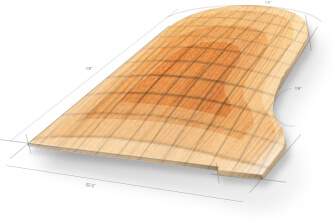

In other words, the soundboard is a "board that transmits vibrations," while at the same time, it is in a certain sense, a "board that stops vibrations." What makes the spruce family, and especially Alaskan (Sitka) spruce, so highly valued as soundboard materials is that these species have the property of absorbing the higher overtones more effectively. The reason why this does not occur is because wood, the material from which the soundboard is made, cuts off the higher harmonic components (overtones), leaving only those components of the sound that are musical, that sound good to our ears, transforming them into a richer, more resonant tone. If this sound were to be amplified as is, the piano would end up being a giant noise generator. There are certain things you should know about soundboards: Tight cracks usually present no problems. Like the top of a Stradivarius violin, the soundboard is the wood beneath all the strings and plate of the piano which gives it its unique quality of sound.
#Piano soundboard full
If you listen closely and focus only on the sound the struck strings make, you would find that it is full of metallic jangling noises. The heart and soul of your piano is its soundboard. For the higher frequencies, it does the opposite: it cuts them off. So why is the soundboard made from wood? The answer is that, unlike metal, which amplifies both low and high frequency sounds in the same way, wood amplifies only the lower-frequency sounds. If it were only a matter of loudly amplifying the sound produced when the hammers strike the strings, a metal plate would have been much more efficient. What Is A Piano Soundboard ApPeter An ideal piano soundboard is typically made of spruce roughl圓/8 thick, glued together, and stretching from the bottom of the piano along a vertical, inclined back, into an array between the pin-on bar and the piano body, all the way across all its width. In contrast, the soundboard that translates their energy into a rich, resonant sound is made of wood. Please check out photos of old and new boards.Piano strings are made of steel. Soon the board will be flatter than ever. Not permanently, propping up and shimming a soundboard will re-crown a soundboard only temporarily. Piano makers don't make pianos soundboards with cracks, loose ribs, week crown, poor sustain, rattles, strange hums, and other offensive sounds. The new soundboard should be patterned after the old board. The old boards usually have many problems that will never get better. No, The new soundboard restores the tone back to it's original sound. Does a new soundboard radically change the character of the sound. A board with poor crown will be flat after removal.Ĭlick here to see pictures of an old bad board, an old good board, and a new good board

A good board that must be removed under rare circumstances will still have crown. Previous work is usually lost.Īfter the soundboard is removed it's easy to see exactly the condition of the old board. Also, to fix a soundboard later the whole piano has to be taken apart again. rim, and a number of other problems that keep the piano from sounding it's best. Humidity fluctuations cause soundboards to become full of cracks, loose ribs and to come loose from their parameter. Soundboards are under several hundred pounds of pressure causing them to lose their crown. A good board will return the sound back to the sound it had when it was new. That situation is very unfortunate since you have to undue the just completed work to get to the soundboard. Sometimes an old board just can't get anything other than a mediocre tone. It's very unfortunate when, after shimming the soundboard, replacing and voicing hammers, pinblock, strings, etc., that the piano sounds tone is a disappointment. The quality of materials and the current techniques are far better than ever for soundboard replacement. The day is coming (if it isn't already here) that all serious rebuilders will be doing it. Not to long ago soundboard replacement was far beyond the average piano rebuilder. BOB DILLINGER PIANO SERVICE - Soundboards - to replace or not to replace return to main menu Soundboards - to replace or not to replace?


 0 kommentar(er)
0 kommentar(er)
